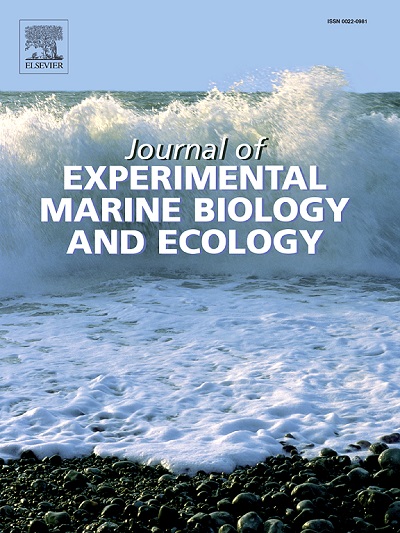The impact of environmental conditions on the heat tolerance of Acropora hyacinthus
IF 1.8
3区 生物学
Q3 ECOLOGY
Journal of Experimental Marine Biology and Ecology
Pub Date : 2025-03-06
DOI:10.1016/j.jembe.2025.152096
引用次数: 0
Abstract
While coral bleaching events are becoming increasingly frequent due to climate change, some nearshore zones exposed to high turbidity and cold-water upwelling may serve as thermal refuges to effectively mitigate the effects of heat stress. Understanding how corals in these zones adapt to environmental stressors can aid in coral management. In this study, we collected Acropora hyacinthus from two zones near Hainan Island: Changjiang, a nearshore coastal zone with high turbidity, and Wuzhizhou, a zone affected by the Qiongdong upwelling in the summer. The corals were subjected to heat stress in the laboratory up to 32 °C, and their responses were compared and analyzed. A. hyacinthus from Changjiang exhibited superior thermal tolerance, potentially due to its higher total energy reserves, consistent composition of symbiotic microbial communities (especially the photosynthetically active Symbiodiniaceae C1 and abundance of probiotic bacteria), and stability of metabolic activity. Upon heat stress, it up-regulated various metabolic pathways, including arachidonic acid metabolism, pantothenate and CoA biosynthesis, and ABC transporters, which indicated good adaptive capacity to high-temperature settings. Conversely, A. hyacinthus from Wuzhizhou was more vulnerable. Upon heat stress, it had a notable rise in bacterial diversity, a reduction in the abundance of probiotic bacteria, and down-regulated metabolic pathways. Thus, compared to corals in nearshore turbid zones, corals sheltered by the summer upwelling in the South China Sea east of Hainan Island are more sensitive to rising temperatures and are at a higher risk if the Qiongdong upwelling weakens due to further climate change.
环境条件对风信子耐热性的影响
由于气候变化,珊瑚白化事件变得越来越频繁,一些近岸地区暴露于高浊度和冷水上涌,可以作为热避难所,有效地减轻热应激的影响。了解这些地区的珊瑚如何适应环境压力,有助于珊瑚的管理。本研究在海南岛附近的两个区域采集了风信子Acropora hyacinthus,分别是夏季受琼东上升流影响的近岸高浑浊带长江和夏季受琼东上升流影响的无支州。珊瑚在实验室中受到高达32°C的热应激,并比较和分析它们的反应。长江风信子表现出较强的耐热性,可能是由于其总能量储备较高,共生微生物群落组成一致(特别是光合活性较强的共生菌科C1和丰富的益生菌),代谢活性稳定。在高温胁迫下,它上调花生四烯酸代谢、泛酸和辅酶a生物合成以及ABC转运蛋白等多种代谢途径,显示出对高温环境的良好适应能力。相反,蜈支洲州的风信子则更脆弱。在热应激下,细菌多样性显著增加,益生菌丰度减少,代谢途径下调。因此,与近岸浑浊带的珊瑚相比,海南岛以东南海夏季上升流庇护的珊瑚对气温上升更敏感,如果琼东上升流因气候进一步变化而减弱,珊瑚面临的风险更高。
本文章由计算机程序翻译,如有差异,请以英文原文为准。
求助全文
约1分钟内获得全文
求助全文
来源期刊
CiteScore
4.30
自引率
0.00%
发文量
98
审稿时长
14 weeks
期刊介绍:
The Journal of Experimental Marine Biology and Ecology provides a forum for experimental ecological research on marine organisms in relation to their environment. Topic areas include studies that focus on biochemistry, physiology, behavior, genetics, and ecological theory. The main emphasis of the Journal lies in hypothesis driven experimental work, both from the laboratory and the field. Natural experiments or descriptive studies that elucidate fundamental ecological processes are welcome. Submissions should have a broad ecological framework beyond the specific study organism or geographic region.
Short communications that highlight emerging issues and exciting discoveries within five printed pages will receive a rapid turnaround. Papers describing important new analytical, computational, experimental and theoretical techniques and methods are encouraged and will be highlighted as Methodological Advances. We welcome proposals for Review Papers synthesizing a specific field within marine ecology. Finally, the journal aims to publish Special Issues at regular intervals synthesizing a particular field of marine science. All printed papers undergo a peer review process before being accepted and will receive a first decision within three months.

 求助内容:
求助内容: 应助结果提醒方式:
应助结果提醒方式:


